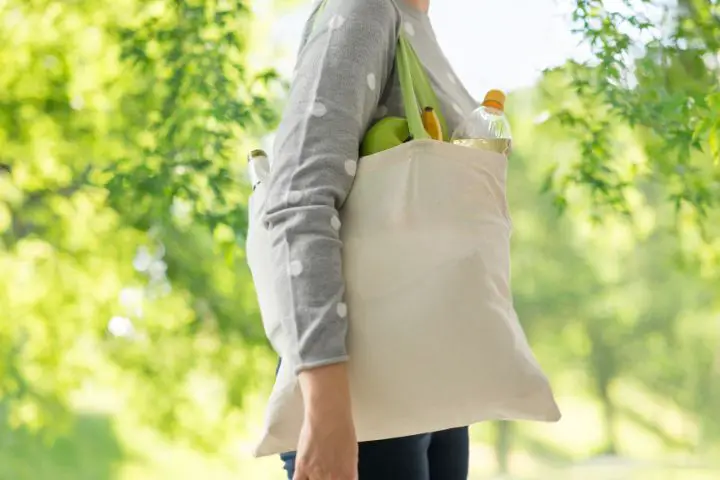7 Do’s And 4 Don’ts Of Sustainable Shopping
Shopping sustainably sounds very much like an oxymoron! Is it even possible?
Let’s face it consumerism is rarely environmentally friendly! On the other hand, that’s how society operates. Hardly anyone can avoid shopping!
The next best thing is to be mindful of how we go about it and what we can do to minimise our shopping footprint.
Some of us are trying to modify our lifestyles to minimize our environmental impact. And if you’re ready to join this battle against global warming, one of the baby steps you can take is to start shopping sustainably.
Surprisingly, lots of small acts of sustainability can be a step in the right direction for the planet. If zero-waste living is a far-fetched idea, for now, you can start slow and small. You may begin by gradually changing your shopping habits and practices for now.
Having said that, here are the dos and don’ts of sustainable shopping.
Do’s

1. Bring Your Reusable Eco Bag
Plastic waste accumulates in landfills, and you cannot help but use plastic bags every time you shop. Unfortunately, these plastic bags get ripped easily, soiled and dirty, resulting in you having to throw them in garbage bins. The best solution for this is to get rid of plastic bags and go for reusable eco bags at alburyenvirobags.com and other eco-bag suppliers instead.
You can avoid accumulating waste by not using the checkout bag when shopping. The products you buy at some stores are bagged in plastic bags provided by the stores, but you can avoid using them and go for your eco bag instead. This way allows your shopping experience to be more sustainable and guilt-free.
It’s easy to carry eco bags from one store to another because they are lightweight and durable. Also, even when they get dirty, wet, and ripped, you can wash and sew them so you can still continue using them for a long time. It’s a great trick to shop sustainably indeed.
Additionally, you can choose a larger bag size to ensure everything you purchase will fit. A reusable bag is also useful for other purposes besides shopping. You can use it as a normal bag when you’re out and about. Some eco bags come with trendy prints, colors, and designs, allowing you to match them with your casual outfits. You can use it when running simple errands or just chilling in the park.
2. Consider Product Packaging
Unfortunately, many companies still use a lot of plastic in their packaging. In fact, a large number of products sold worldwide are packaged with plastic materials. Many products are packaged unsustainably, from plastic food containers to bottles. If you want to change your lifestyle, you can focus on choosing the right product packaging. In doing so, you can reduce trash at your home too.
Instead of choosing plastic bottled drinks, go for cartons instead. Or better yet, go for glass bottles that can be reused at home. When shopping, it’s essential to consider the product packaging in order to be mindful of your environmental impact. Try to shop for goods that are packed in sustainable materials instead of plastic. This small way can make a great impact in the long run.
Check out these plastic-free products: Earth Breeze Review and Tru Earth Eco Strips
3. Buy From Local Businesses
Another tip for sustainable shopping is considering the distance traveled by a product. Although not all people put a lot of thought into this detail, it’s actually important. Sustainable shopping means going for products that are locally sourced. There are many reasons to shop local and support small businesses, so buy local items as much as possible.
Since they’re sourced out in the same local place, they don’t have to waste gas and other resources to transfer the goods to your location. It results in lesser carbon dioxide emissions and cheaper travel costs. Another advantage to local shopping is that fresh food tastes much better when it travels less, making it a healthier alternative. Buy seasonal produce if you want to be sure it’s locally harvested.

4. Go For Sustainable Products
Fortunately, as businesses become more aware of the potential dangers of global warming, many have changed how they manufacture their products. Instead of using components and ingredients that are harmful to the environment, they stick to organic and sustainable ones.
Choose organic products to reduce exposure to harmful chemicals and pesticides when shopping. Whether you purchase food, clothes, and other essentials, try to read the label and its production process. Some products are labeled by sustainable organizations or groups, so try to patronize them instead. Whatever product you want to shop for, try to go for those that have been sustainably sourced or manufactured.
5. Shop For Investment Items
Some things have reasons why they’re priced cheaply. Aside from poor quality, they might have been exhausting resources wastefully. One good way to practice sustainable shopping is to stop buying poor-quality and cheap items. Chances are you’ll break them faster, which means you’ll buy new ones all over again. Not only will this waste your money, but you’ll also hoard more and lose your space at home, accumulating such rubbish.
Therefore, it’s time to change your shopping habit and stick to investment items instead. You don’t have to replace investment pieces as often if you choose them wisely. Instead of having a garment fall apart after one wash cycle and a few wears, you can continue wearing high-quality clothes for many years. As a side tip, go for timeless styles so they will appear trendy for many decades.
6. Learn About Sustainable Brands
Researching different brands ahead of time may be helpful if you want to practice sustainable shopping. As mentioned, there are a growing number of sustainable companies today. From skincare and fragrances to clothes and shoes, some products are environmentally friendly. And it’s all a matter of knowing these brands.
Stay away from products that have production processes that are unsustainable or unethical. In the long run, it may not be sustainable to patronize them by purchasing their products. The best way to reduce your carbon footprint is to shop from brands that offer more sustainable products. The key is to do your research, read blogs, and find recommendations from people or communities that share the same views about sustainable shopping.
7. Consider Shopping For Preloved Items
Another wise way to live sustainably is to open your mind towards preloved shopping. The truth is a man’s waste can be someone else’s treasure. Someone may no longer want to wear that leather jacket that no longer fits them. However, throwing the jacket in the landfill would be a waste. The best solution is to sell them as a preloved item instead.
There are many ways to buy and sell preloved stuff. One way is to use social media platforms or use third-party websites. Another way is to go preloved shopping from thrift stores. Buying preloved items is hitting two birds with one stone, which means you save a lot of money since these products are priced way cheaper. At the same time, you can help save the environment.
Don’ts

1. Don’t Focus On Trends
When it comes to shopping, it is easy to let trends influence your choices. Because of social media and internet marketing, trends are fast-paced and constantly changing. Nevertheless, you should remember that trendy products are not always practical or sustainable. Trends come and go, and it’s not good to follow through.
If you want to make environmentally friendly choices, don’t follow the trends and stick to your personal preferences and style instead. Before making a purchase, determine what kind of style you’re going for. It’s a good habit to read customer reviews to see how other customers perceive the product.
2. Don’t Shop In A Rush
Another good sustainable practice is to take your time when shopping. It’s important not to purchase anything on impulse. It’s good practice to plan ahead or create a shopping list. Without planning, there’s a huge chance of shopping for more items than you wished or planned. It’s always a good idea to prepare grocery lists and keep spare cloth bags in your car to ensure that you’re always prepared in case you make an unplanned purchase.
The choice of products you buy isn’t the only aspect of shopping sustainably. You should also only purchase what you need. Buying excessively will only lead to wastage, and hoarding items at home will lead to more clutter which you will later need to throw out. It would be impossible to avoid throwing them away eventually. This practice may only increase environmental waste. Therefore, avoiding impulsive purchases can help you develop sustainable habits.
3. Don’t Support Greenwashing Companies
With the rising trend for sustainable products, more companies are joining the bandwagon and claiming that their products are also green and sustainable. Unfortunately, their practices don’t follow through. It’s what greenwashing refers to.
If you want to shop sustainably, you should be aware of the brands and companies that practice greenwashing. Some companies claim their products have sustainable components and materials, but they’re actually deceiving their customers. You need to be on the lookout for companies that take shortcuts regarding sustainability and fail to follow through with real eco-friendly actions.
Final Thoughts on Shopping Sustainably

Making small changes to your shopping habits can lead to sustainable shopping. Don’t forget to get rid of plastic waste by using your eco bag for shopping. Apply the different practices mentioned above, and you’ll be on your way to shopping sustainably.






